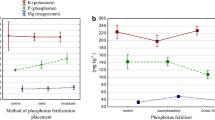Summary
Some soil and plant test methods were evaluated for predicting response of soybean crop (Glycine max (L.) Merr.) to S application in vertisols. Morgan's reagent, 500 ppm P containing Ca(H2PO4)2.H2O and KH2PO4 solutions, 0.5N NH4OAc+0.25N HOAc and 0.15% CaCl2 were found to be suitable extractants for measuring available soil S. The critical limits of extractable S were 9.0 ppm by Morgan's reagent, 10.0 ppm by phosphate solutions, 8.0 ppm by 0.5N NH4OAc +0.25N HOAc and 14.0 ppm by 0.15% CaCl2. Morgan's reagent was regarded as superior to other soil test methods in view of its high relationship with S uptake by plants, A values and relative yield. Critical S concentration in soybean plants varied with age. It was 0.15% and 0.185% for 36 and 60 days old plants, respectively. The critical N/S ratio on the other hand appeared to be constant at about 16.5 during vegetative growth period. Constancy of critical N/S ratio in plants was attributed to the near constancy of N/S ratio in plant proteins. There was highly significant relationship between response of soybean to S and to N, supporting the conclusion of some earlier workers that any soil showing large responses to N may not be supplying adequate S from the mineralization of soil organic matter.
Similar content being viewed by others
References
Anonymous 1971–1980 Madhya Pradesh Agricultural Statistics, Directorate of Agriculture, Madhya Pradesh, Bhopal.
Bansal K N 1976 Evaluation of soil and plant test methods and crop response to sulphur applications using S35 in medium black soils of Madhya Pradesh. Ph.D. Thesis Department of Soil Science and Agricultural Chemistry, J.N. Krishi Vishwa Vidyalaya, Jabalpur.
Black C A 1965 Methods of Soil Analysis. Monograph No. 9, Part I and Part II, American Society of Agronomy Madison, Wisconsin, U.S.A.
Cate R B Jr and Nelson L A 1965 A rapid method for correlation of soil tests analyses with plant response data. North Carolina State Agr. Expt. Stn. Tech. Bull. 1, International Soil Testing Series.
Dijkshoorn W, Lampe J E M and Van Burg D F J 1960 A method of diagnosing the sulphur nutrition status of herbage. Plant and Soil 13, 227–241.
Ensminger L E 1954 Some factors effecting the adsorption of sulfate by Alabama Soils. Soil Sci. Soc. Am. Proc. 18, 259–264.
Ensminger L E and Freney J R 1966 Diagnostic techniques for determining sulfur deficiencies in crops and soils. Soil Sci. 101, 283–290.
Fox R L, Olson R A and Rhoades H F 1964 Evaluating sulphur status of soils by plant and soils tests. Soil Sci. Soc. Am. Proc. 28, 243–246.
Fried M and Dean L A 1952 A concept concerning the measurement of available soil nutrients. Soil Sci. 73, 263–271.
Harward M E, Chao T T and Fang S C 1962 The sulfur status and sulfur supplying power of Oregon soils. Agron. J. 54, 101–106.
Motiramani D P and Pal A R 1971 Plant tests for judging sulphur deficiency. JNKVV Res. J. 5, 77–85.
Pal A R and Motiramani D P 1971 Evaluation of some soil test methods for measuring available sulphur in medium black soils. Proc. Int. Symp. Soil Fert. Evaln. New Delhi, 297–307 pp.
Patel K S, Sawarker N J, Khanna S S and Motiramani D P 1973 Study of response of sulphur on soils of Madhya Pradesh. Proc. Int. Symp. Isotopes and Radiations, New Delhi. pp 555–565.
Sanford J O and Lancaster J D 1962 Biological and chemical evaluation of readily available sulfur status of Mississippi soils. Soil Sci. Soc. Am. Proc. 26, 63–65.
Stewart B A and Porter L K 1969 Nitrogen-sulphur relationships in wheat (Triticum aestivum L.), corn (Zea mays), and beans(Phaseolus vulgaris). Agron. J. 61, 267–271.
Stewart B A and Whitfield C J 1965 Effect of crop residue, soil temperature, and sulfur on growth of winter wheat. Soil Sci. Soc. Am. Proc. 29, 752–755.
Vogel A I 1961 A Text Book of quantitative inorganic Analysis. English Language Book Society and Longmans, Green and Co. Ltd., London.
Williams C H and Steinbergs A 1959 A soil sulphur fractions as chemical indices of available sulphur in some Australian soils. Aust. J. Agri. Res. 10, 340–352.
Author information
Authors and Affiliations
Rights and permissions
About this article
Cite this article
Bansal, K.N., Motiramani, D.P. & Pal, A.R. Studies on sulphur in vertisols. Plant Soil 70, 133–140 (1983). https://doi.org/10.1007/BF02374756
Received:
Revised:
Issue Date:
DOI: https://doi.org/10.1007/BF02374756




